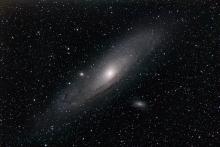Listen to today's episode of StarDate on the web the same day it airs in high-quality streaming audio without any extra ads or announcements. Choose a $8 one-month pass, or listen every day for a year for just $30.
You are here
Galactic Collision
The Milky Way is headed toward a galactic pile-up. Our home galaxy is likely to merge with M31, our closest big neighbor galaxy. That will trigger the birth of millions of new stars. And it will fling the Sun and its planets into a new orbit — and perhaps out of the galaxy entirely. There’s no need to worry about it, though. It won’t start for another four and a half billion years.
M31 — also known as the Andromeda Galaxy — is about two and a half million light-years away. But it’s moving toward us. Every hour, it covers about a quarter of a million miles — roughly the distance between Earth and the Moon.
The Gaia satellite measured the precise motions of more than a thousand stars in M31. A team of astronomers used those measurements to come up with a better timeline of the encounter.
The team calculated that M31 will pass about 400,000 light-years from the Milky Way in four and a half billion years. The haloes of “dark matter” that envelop the galaxies will create friction. That’ll slow the galaxies down and pull them together.
They’ll pass through each other a few times. Each encounter will fling huge ribbons of stars out of each galaxy. There’s a chance the Sun could get caught in such a ribbon, carrying Earth along with it. The merger also will trigger intense bouts of starbirth — creating millions of new stars.
Eventually, Andromeda and the Milky Way will merge, creating a single monster galaxy — the final result of a galactic pile-up.
Script by Damond Benningfield





